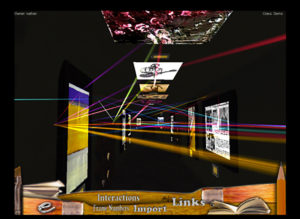Artistic Data Visualization and Assessment in Art Education
By Pamela G. Taylor
In this article the author explores the possibilities for online and offline data visualization and assessment in teaching art. Taylor touches upon the use of data visualization software such as eLASTIC, IOGraphica, Diigo, and Tinderbox. How frequently are these programs actually used by art educators for assessment today? Have they had any success with using these tools to reflect upon their students’ needs, performance and progress? Is digital software or offline sketching and drawing more effective as a data visualization assessment tool?
I definitely would be interested in using the offline method of juxtaposing words, ideas, images, sketches, and concepts in individual students’ sketchbooks, or shared student/teacher sketchbooks like these ones:



However I would like to learn more about how we can use the online data visualization assessment tools that were mentioned; and find out who is using these with any success:
Source: https://www.press.uillinois.edu/journals/var/media/43.1/taylor/index.html
Assessment for Learning in Art
By Michelle Wiebe Zederayko, George Brown College
In this article the author believes that both certification (summative assessment) and aiding learning (formative assessment) should be “woven together” so that learning is enhanced (p. 253). Zederakyo refers to Boud (2000) who points out that summative assessment “provides an authoritative statement of what counts”, while formative assessment “guides us in how to learn and it tells us how well we are doing in progress to get there” (p.253). Zederakyo explains that “features such as frequency, clarity, student involvement, the use of exemplars and descriptive statements, and consideration of process have all been shown to increase effectiveness of assessment in enhancing student learning” (p.253). The author then illustrates the use of student reflections on the above assessment features in order to explore their responses to them. Students preferred ongoing feedback, clear reasons for marking/rubrics, and clarity around expectations and how to do self-assessment. Students also preferred to be involved in the process and to get both good and bad examples of the artwork that is expected of them (exemplars).
I believe that if students knew that self-assessment would not in some way damage their final grades that they would gain a lot more from it. Instead of calling it “self-assessment”, which sounds very formal, why not just call it “reflection on progress & challenges”, and make it so that it is just a reflection on their process and progress rather than using it as part of the grade? The students would be asked to write say 200 words on this and then they would receive participation points for completing the full write-up. In my experience most students just give themselves 90 to 100% because they are afraid that anything less might lower their grade, and they don’t use it as an opportunity to learn about their process because it is not framed properly by the teacher. In my experience, creating a more positive and supportive framework allows students not only to perform better but they also feel more open to share how things are going for them.

